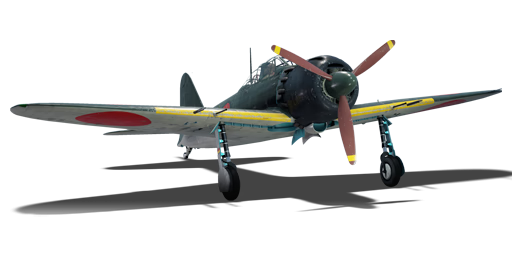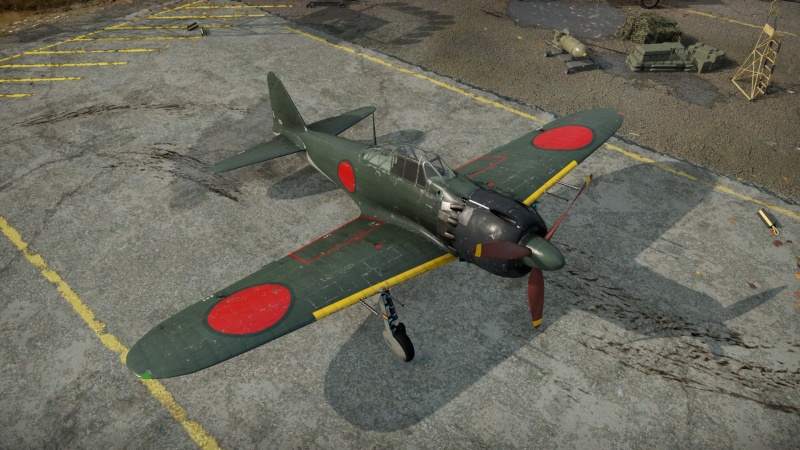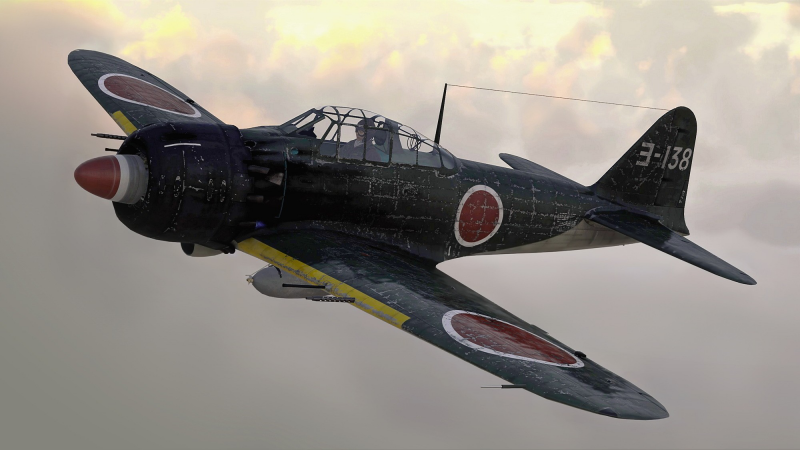Difference between revisions of "A6M6c"
Colok76286 (talk | contribs) (Edits) |
k_chan_95th (talk | contribs) (→Usage in battles: Added a optimal angle to climb while in a A6M6c and a reminder to be careful around bombers due to how it cannot take punishment very much) (Tag: Visual edit) |
||
| Line 113: | Line 113: | ||
<!-- ''Describe the tactics of playing in the aircraft, the features of using aircraft in a team and advice on tactics. Refrain from creating a "guide" - do not impose a single point of view, but instead, give the reader food for thought. Examine the most dangerous enemies and give recommendations on fighting them. If necessary, note the specifics of the game in different modes (AB, RB, SB).'' --> | <!-- ''Describe the tactics of playing in the aircraft, the features of using aircraft in a team and advice on tactics. Refrain from creating a "guide" - do not impose a single point of view, but instead, give the reader food for thought. Examine the most dangerous enemies and give recommendations on fighting them. If necessary, note the specifics of the game in different modes (AB, RB, SB).'' --> | ||
| − | To master the A6M6c in the air, the pilot needs to channel all of the Zero's strengths and exploit them against the enemy. The primary goal is to set up a turning engagement and open fire roughly 300 meters from the target in a turn. The Zero is vulnerable to energy fighting tactics, so it isn't recommended to boom and zoom, as the Zero isn't a fast aircraft. The A6M6c has a poor rate of climb, and it is recommended to side climb slightly and engage targets that are low in energy and altitude. | + | To master the A6M6c in the air, the pilot needs to channel all of the Zero's strengths and exploit them against the enemy. The primary goal is to set up a turning engagement and open fire roughly 300 meters from the target in a turn. The Zero is vulnerable to energy fighting tactics, so it isn't recommended to boom and zoom, as the Zero isn't a fast aircraft. The A6M6c has a poor rate of climb, and it is recommended to side climb slightly and engage targets that are low in energy and altitude. While side climbing, the most optimal angle to do so is around 20° and nothing more. This will allow you to climb without stalling your engines. When attacking bombers, one thing to take note is that a experienced bomber gunner can obliterate you out of the sky due to how relatively frail the airframe is. Your fighter cannot take much punishment so make sure to only pick targets that you can kill easily. |
=== Manual Engine Control === | === Manual Engine Control === | ||
Revision as of 15:06, 31 October 2021
| This page is about the Japanese fighter A6M6c. For other versions, see A6M (Family). |
Contents
Description
The A6M6c is a premium gift rank IV Japanese fighter with a battle rating of 5.0 (AB/RB) and 4.7 (SB). It was introduced during Update "Red Skies" as a reward for Battle Pass: Season IV, "Fearless Voltigeur".
General info
Flight performance
With the new Sakae 31a engine, the A6M6c has a water-methanol injection that makes the engine less vulnerable to overheating under WEP. The main flaw of this engine is that once the water-methanol mixture runs out, WEP cannot be utilized anymore. The B7A2 also shares this similar flaw with the A6M6c. The WEP lasts for a total of 8 minutes, so it's recommended to conserve it once cruising altitude is reached. Saving a few minutes of WEP for a dogfight can make a vital difference in combat effectiveness. In total, the WEP setting adds 136 additional horsepower compared to 100% throttle setting.
The general flight performance of this Zero will match the traditional expectations. It is relatively light and nimble, it has an excellent turn rate, and it has great low altitude performance. However, when compared with other late war zeros such as the A6M5 Ko/Otsu, it feels much heavier and more sluggish. It also has a rather poor rate of climb. It behaves similarly to the A6M5 Hei, and if the pilot is familiar with the Hei, the pilot can master the A6M6.
| Characteristics | Max Speed (km/h at 6,400 m) |
Max altitude (metres) |
Turn time (seconds) |
Rate of climb (metres/second) |
Take-off run (metres) | |||
|---|---|---|---|---|---|---|---|---|
| AB | RB | AB | RB | AB | RB | |||
| Stock | 522 | 506 | 10900 | 20.9 | 21.7 | 7.8 | 7.8 | 350 |
| Upgraded | 566 | 543 | 19.1 | 20.0 | 14.4 | 10.7 | ||
Details
| Features | ||||
|---|---|---|---|---|
| Combat flaps | Take-off flaps | Landing flaps | Air brakes | Arrestor gear |
| ✓ | ✓ | ✓ | X | ✓ |
| Limits | ||||||
|---|---|---|---|---|---|---|
| Wings (km/h) | Gear (km/h) | Flaps (km/h) | Max Static G | |||
| Combat | Take-off | Landing | + | - | ||
| 740 | 300 | 398 | 369 | 220 | ~14 | ~6 |
| Optimal velocities (km/h) | |||
|---|---|---|---|
| Ailerons | Rudder | Elevators | Radiator |
| < 280 | < 420 | < 410 | > 336 |
Survivability and armour
The A6M6c boasts pilot armour, armoured glass, and self-sealing fuel tanks, elements missing on earlier models of the A6M. It has increased survivability because of these bonus features. However, it isn't as tough as a P-51, as it is still a Zero, and the wings are vulnerable to incendiary rounds. The armour will save you, but you should not rely on it as your primary advantage.
Modifications and economy
Armaments
Offensive armament
The A6M6c is armed with:
- 2 x 20 mm Type 99 Model 2 cannons, wing-mounted (125 rpg = 250 total)
- 1 x 13.2 mm Type 3 machine gun, nose-mounted (230 rpg)
- 2 x 13.2 mm Type 3 machine guns, wing-mounted (240 rpg = 480 total)
Suspended armament
The A6M6c can be outfitted with the following ordnance:
- Without load
- 2 x 60 kg Navy Type 97 Number 6 bombs (120 kg total)
- 1 x 250 kg Navy Type Number 25 Model 2 bomb (250 kg total)
- 10 x Type 3 No.1 Mod.28 Mk.1 rockets
- 2 x Type 3 No.6 Mod.27 Mk.1 rockets
Usage in battles
To master the A6M6c in the air, the pilot needs to channel all of the Zero's strengths and exploit them against the enemy. The primary goal is to set up a turning engagement and open fire roughly 300 meters from the target in a turn. The Zero is vulnerable to energy fighting tactics, so it isn't recommended to boom and zoom, as the Zero isn't a fast aircraft. The A6M6c has a poor rate of climb, and it is recommended to side climb slightly and engage targets that are low in energy and altitude. While side climbing, the most optimal angle to do so is around 20° and nothing more. This will allow you to climb without stalling your engines. When attacking bombers, one thing to take note is that a experienced bomber gunner can obliterate you out of the sky due to how relatively frail the airframe is. Your fighter cannot take much punishment so make sure to only pick targets that you can kill easily.
Manual Engine Control
| MEC elements | ||||||
|---|---|---|---|---|---|---|
| Mixer | Pitch | Radiator | Supercharger | Turbocharger | ||
| Oil | Water | Type | ||||
| Controllable | Controllable Not auto controlled |
Controllable Not auto controlled |
Controllable Not auto controlled |
Separate | Controllable 2 gears |
Not controllable |
The Zero's manual engine controls are simple to learn. The propeller pitch should be kept at 95% at all times. The radiators both should be kept between 5 and 15% depending if you are on a hot or cold map. The second supercharger gear should be activated at 3,500 m and above. The Mixture can be kept at 60% percent for all altitudes.
Pros and cons
Pros:
- Powerful armament with good ammo count, the 13 mm MGs are effective
- Retains some of the famous manoeuvrability of the A6M series, makes for a capable dogfighter
- Has some armour, combined with better guns it makes the plane capable for bomber hunting
- Can carry effective rockets
- Stronger WEP than earlier Zeros
- Capable of carrier landing and takeoff
Cons:
- Heavier than other zeros, does not handle as well
- Vulnerable to incendiary rounds
- Very poor top speed
- Not potent at high altitude
- Limited WEP mode. Only 8 minutes of WEP.
- Rockets are launched two at a time, limiting the amount of targets you can destroy
History
In late 1944 into early 1945, the skies over the Pacific Ocean were ruled by US military aviation. The Japanese Empire was forced to deploy the already obsolete Zero against up-to-date Corsairs and Hellcats, because the development of new models of carrier-based fighter aircraft was delayed, and new Japanese army fighters often lacked range to win a tactical initiative. The design team of Mitsubishi did everything possible in an attempt to bring the Zero to the level of modern Allied combat aviation.
One of the latest versions of the Japanese carrier-based fighter was the Model 53 hei (A6M6c), developed after the design of the previous version, the A6M5 hei. Efforts to strengthen the structure and increase firepower were also traced in the new model: the A6M6c, like its predecessor, was armed with a pair of automatic cannons and three high-caliber machine guns, and also had protected wing tanks. In addition, this modification was supposed to install a new Nakajima Sakae 31 engine with a water-methanol injection system. As tests showed, the promising afterburner proved to be very unreliable in operation, so only a few A6M6c units were produced - one prototype at the Mitsubishi plant and several units of the testing batch at the Nakajima plant.
-From Devblog
Media
- Skins
- Videos
See also
Links to the articles on the War Thunder Wiki that you think will be useful for the reader, for example:
- reference to the series of the aircraft;
- links to approximate analogues of other nations and research trees.
External links
| Mitsubishi Company (三菱商会) | |
|---|---|
| Fighters | A5M4 · Hagiri's A5M4 |
| A6M2 mod. 11 · A6M2 · A6M3 · A6M3 mod. 22 · A6M3 mod. 22Ko · A6M5 · A6M5 Ko · A6M5 otsu · A6M5 Hei · A6M6c | |
| A7M1 (NK9H) · A7M2 | |
| J2M2 · J2M3 · J2M4 Kai · J2M5 · J2M5 (30 mm) | |
| Hydroplanes | F1M2 |
| Interceptors | Ki-83 · Ki-109 |
| Bombers | G4M1 |
| Ki-21-Ia · Ki-21-I hei · Ki-67-I Ko · Ki-67-I otsu | |
| Jet Fighters | Ki-200 |
| Captured | ▃A6M2 · ␗A6M2 |
| See also | Mitsubishi Heavy Industries, Ltd. (Post-War) |
| Japan fighters | |
|---|---|
| Navy | |
| Carrier-based fighter | |
| A5M | A5M4 · Hagiri's A5M4 |
| A6M | A6M2 mod. 11 · A6M2 · A6M3 · A6M3 mod. 22 · A6M3 mod. 22Ko · A6M5 · A6M5 Ko · A6M5 otsu · A6M5 Hei · A6M6c |
| A7He | A7He1* |
| A7M | A7M1 (NK9H) · A7M2 |
| Land-based Fighter | |
| J2M | J2M2 · J2M3 · J2M4 Kai · J2M5 · J2M5 (30 mm) |
| J6K | J6K1 |
| J7W | J7W1 |
| N1K-J | N1K1-Ja · N1K2-J · N1K2-Ja |
| Fighter seaplane | |
| N1K | N1K1 |
| A6M-N | A6M2-N |
| Army | |
| Ki-10 | Ki-10-I · Ki-10-I C · Ki-10-II · Ki-10-II C |
| Ki-27 | Ki-27 otsu · Ki-27 otsu Tachiarai |
| Ki-43 | Ki-43-I · Ki-43-II · Ki-43-III otsu |
| Ki-44 | Ki-44-I · Ki-44-I 34 · Ki-44-II otsu · Ki-44-II hei |
| Ki-61 | Ki-61-I ko · Ki-61-I otsu · Ki-61-I hei · Tada's Ki-61-I hei · Ki-61-I tei · Ki-61-II Otsu Kai |
| Ki-84 | Ki-84 ko · Ki-84 otsu · Ki-84 hei |
| Ki-87 | Ki-87 |
| Ki-94 | Ki-94-II |
| Ki-100 | Ki-100 · Ki-100-II |
| Other countries | ▅F4U-1A · ▅P-51C-11-NT · ▅Bf 109 E-7 · ▅Fw 190 A-5 |
| *Imported designation of the He 112 (A6M was in development - A7M would take A7 designation after the cancelation of the A7He) | |
| Japan premium aircraft | |
|---|---|
| Fighters | Hagiri's A5M4 · A7He1 · Ki-27 otsu Tachiarai |
| Ki-44-II otsu · ▅Bf 109 E-7 · ▅F4U-1A · Ki-100-II · Ki-44-I 34 | |
| ▅Fw 190 A-5 · A7M1 (NK9H) · Tada's Ki-61-I hei · ▅P-51C-11-NT | |
| J2M4 Kai · A6M5 Ko · A6M6c · J2M5 · Ki-87 · J6K1 | |
| Twin-engine fighters | Ki-96 |
| Jet fighters | F-86F-40 JASDF▅ · T-2 Early · F-4EJ ADTW |
| Strike aircraft | ▄AV-8S |
| Bombers | Ki-21-I hei · Ki-48-II otsu · H8K3 · B7A2 (Homare 23) · ▅B-17E |






